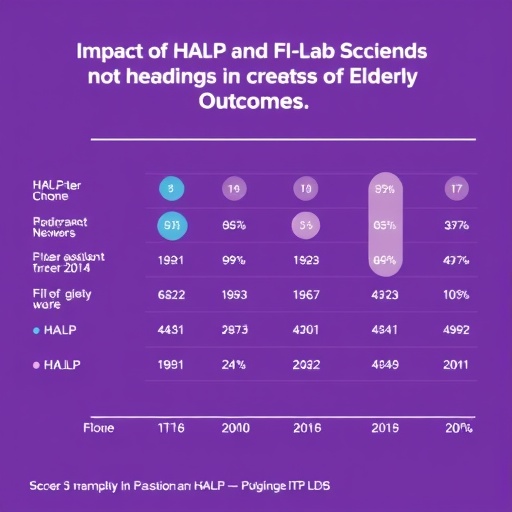In the realm of geriatric medicine, understanding the nuances of patient health is crucial, particularly for hospitalized older adults. A recent study sheds light on the critical evaluation of adverse outcomes among this vulnerable population. The research, authored by Nagae et al., delves into the significance of the HALP and FI-Lab scoring systems. These metrics are pivotal tools that serve to assess the health status and potential risks in elderly patients, thereby facilitating improved clinical decisions.
Older adults often present with a unique set of challenges in healthcare settings that can complicate their treatment and recovery. With the demographic shift that sees an increasing proportion of older adults among the general population, healthcare systems must adapt to these changing dynamics. The HALP (Health Age, Life expectancy, and Patient perspective) and FI-Lab (Frailty Index based on laboratory results) scores aim to offer a comprehensive evaluation framework that can illuminate the complexities faced by older patients during hospitalization.
In this comparative study, the researchers employed a retrospective analysis, examining the outcomes of hospitalized older adults who were assessed using both the HALP and FI-Lab scoring systems. By comparing these two tools, the study aims to identify their levels of effectiveness in predicting adverse outcomes such as mortality, readmission, and other significant health events during hospitalization.
The study’s methodology is meticulous. Researchers gathered data from electronic health records, capturing a diverse array of demographic variables and clinical factors. This comprehensive approach ensures that the findings are robust, reflecting real-world complexities inherent in older adult care. The resulting analysis not only sheds light on patient outcomes but also informs how healthcare providers can tailor interventions to better suit the individual needs of older adults.
One interesting aspect of the study is its exploration of the correlation between frailty and clinical outcomes. Frailty, a common phenomenon among older adults characterized by decreased physiological reserve and increased vulnerability, is integral to understanding the overall health of these patients. By utilizing FI-Lab scores, the study evaluates physiological markers that could indicate frailty, thus enhancing the predictive capability regarding adverse outcomes.
Moreover, the HALP score embraces a holistic perspective, factoring in not just biological metrics but also psychosocial dimensions that might influence patient wellbeing. This multi-faceted approach is essential, as it recognizes that older adults often experience complex health issues that are not solely biological in nature. The interplay of physical, emotional, and social health is critical to comprehensive geriatric assessment and underscores the need for tailored interventions.
As the landscape of healthcare evolves, such studies provide invaluable insights that can pave the way for standardized practices in geriatrics. The incorporation of advanced scoring systems like HALP and FI-Lab into routine assessments could lead to more accurate prognostic evaluations. This could ultimately enhance the framework of care for hospitalized older adults, leading to improved patient outcomes and optimized healthcare resources.
The implications of this research extend beyond individual hospitals and affect broader public health strategies. As healthcare providers and policymakers seek solutions to improve care for older adults, embracing innovative assessment methods becomes increasingly essential. By prioritizing the utilization of reliable tools that enhance patient assessment, the resultant approaches can lead to more defined care pathways, ensuring that older adults receive the attention and treatment they need.
Additionally, this study underscores the significance of collaboration among interdisciplinary healthcare teams. By involving various healthcare professionals—physicians, nurses, social workers, and pharmacists—into the assessment process, elder care can transcend traditional models. This integrative approach fosters a culture of holistic care and shared decision-making that can empower older patients.
Furthermore, the findings reinforce the importance of continuous education and training for healthcare providers. Understanding the latest research developments in geriatric medicine enables clinicians to stay abreast of evolving best practices. Consequently, ongoing professional development is vital in ensuring that healthcare providers are equipped to implement new scoring systems effectively.
While the study’s findings are promising, they also illuminate the challenges that remain in the field of geriatric medicine. Different healthcare settings may face unique barriers to integrating these scoring systems into their assessment protocols. Thus, it’s crucial for future research to address these disparities and propose practical solutions for widespread implementation.
The challenges of geriatric care are exacerbated by societal perceptions of aging and health deterioration. Therefore, overcoming stigma and fostering a culture of respect and dignity for older adults must accompany improvements in clinical methodologies. Engaging communities in discussions around aging, health, and well-being can encourage a supportive environment for older individuals and their families.
Finally, the outcomes of Nagae et al.’s study represent a step forward in the ongoing endeavor to provide superior healthcare to older adults. It serves as a reminder that aging should not be viewed solely through a lens of decline, but rather as a complex journey that requires attention to both biological and psychosocial factors. In harnessing the insights from HALP and FI-Lab scores, healthcare systems can aspire to create a future where every older adult receives personalized, empathetic, and effective care.
In summary, this research by Nagae et al. reflects a profound commitment to advancing geriatric healthcare through evidence-based scoring systems. As the healthcare landscape continues to evolve, innovative approaches that prioritize the unique needs of older adults will play an essential role in shaping future practices and enhancing the quality of care delivered.
Subject of Research: Assessment of Adverse Outcomes in Hospitalized Older Adults using HALP and FI-Lab Scores
Article Title: HALP and FI-Lab Scores in Hospitalized Older Adults: A Retrospective Comparative Study of Adverse Outcomes
Article References:
Nagae, M., Umegaki, H., Nakashima, H. et al. HALP and FI-Lab Scores in Hospitalized Older Adults: A Retrospective Comparative Study of Adverse Outcomes.
J GEN INTERN MED (2025). https://doi.org/10.1007/s11606-025-09889-6
Image Credits: AI Generated
DOI: 10.1007/s11606-025-09889-6
Keywords: older adults, HALP score, FI-Lab score, hospitalization, adverse outcomes, frailty, geriatric medicine




